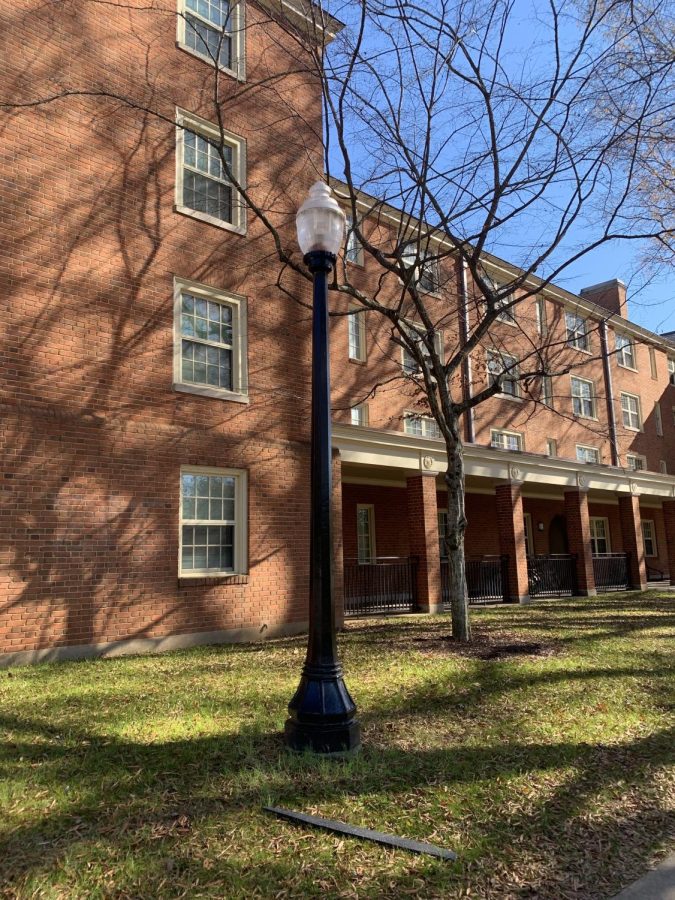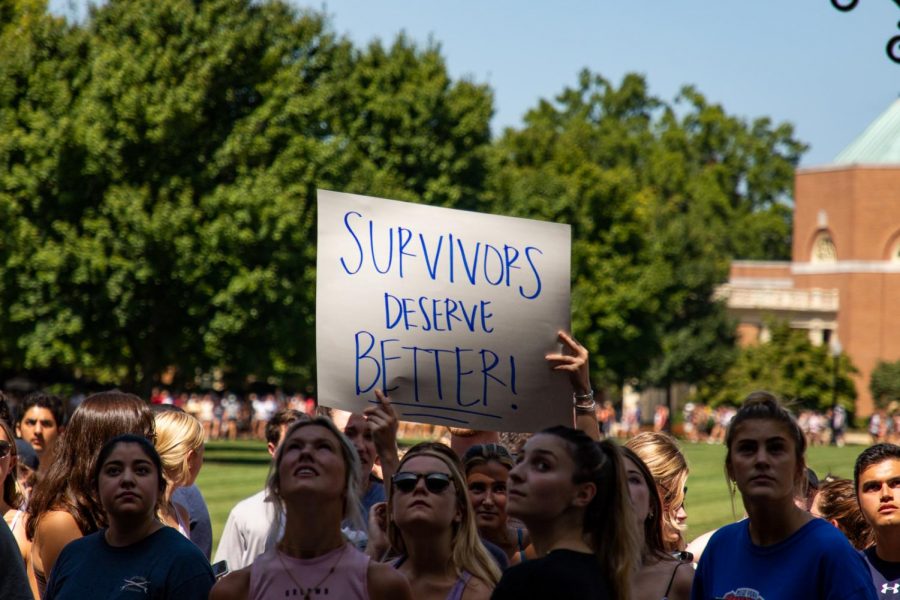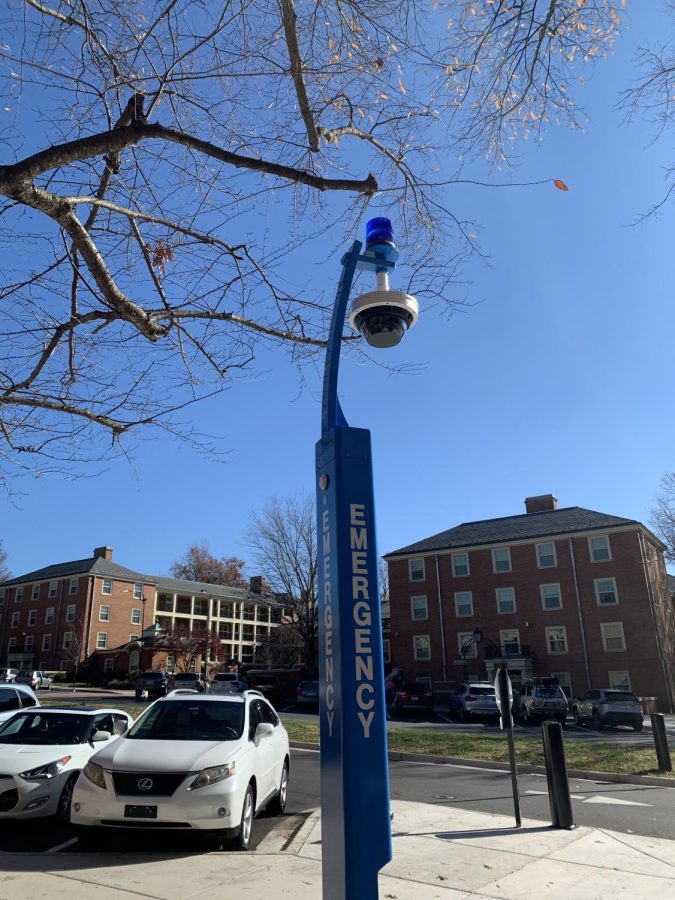‘I do not feel safe:’ A deep dive into Wake Forest campus safety
An Old Gold & Black investigation and the Campus Climate Survey revealed deep issues with campus safety
December 1, 2022
Editor’s Note: For the Old Gold & Black’s investigation, we interviewed Wake Forest students and parents. Per their requests, we will respect these sources’ privacy by having these community members remain anonymous. The student sources have chosen to remain anonymous because they are concerned about the harasser discovering their identities. The parent sources have also requested to remain anonymous due to concern for the safety of their children.
It can be easy to get wrapped up in the Wake Forest “bubble.” Our campus lives rarely interact with those in the outside world of Winston-Salem unless we actively seek out the opportunity to engage with the community. However, when a significant event occurs that affects students on and off-campus, the two worlds become one.
In late October, a suspect was charged with trespassing on Wake Forest property. A community advisory was issued on Oct. 27 that included a photo of the suspect after reports that the suspect had been aggressively approaching Wake Forest students.
Many perceived Wake Forest’s response to this harassment as lackluster, as the university released a minor amount of information until after parents and students voiced concerns on social media. Because of this silence, unsubstantiated rumors circulated about the harasser and his whereabouts, increasing panic amongst the Wake Forest community.
When asked about campus safety with regards to this matter, University Police Department (UPD) Major of Patrol Operations Jamie Herring informed the Old Gold & Black that “the safety and wellbeing of our community comes first.” Herring explained several community safety measures: there are emergency blue-light boxes and security cameras located around campus and security officers staffed at entrance gates from 10 p.m. to 6 a.m.
The Office of Communications and External Relations sent another email on Nov. 14 at 7:22 p.m. informing community members that the individual was banned from campus, and would be arrested immediately if he stepped foot on university property. However, this email left out the detail that the suspect was a former Deacon Dining employee, a fact confirmed by Herring and reported by the Old Gold & Black on Nov. 30. Many felt that the time gap between these updates was too long, especially considering the number of reported sightings that took place during this time — substantiated or not. One sophomore parent who requested to remain anonymous claimed that the “university [downplayed] the situation, which [sets] a dangerous precedent for future criminals.”
One female sophomore student expressed concern over the university’s lack of transparency, and said that she felt that “she [needed] to protect herself” because she does “not feel safe on campus.”
All factors considered, it’s apparent that the university’s security system has major holes in it that need to be filled quickly, a fact that is further signified in the recent Campus Climate Survey results. Completed by 38% of the overall student population — 2,713 students — the survey yielded 55% of participants experiencing sexual assault in the form of sexual harassment, stalking, non-consensual or unwanted sexual contact or intimate partner violence. The survey was based on a 2019 survey conducted by the Association of American Universities (AAU) — an organization of 63 public and private research universities including Stanford University, the University of Virginia, the Massachusetts Institute of Technology and others.
Stalking
As part of the Campus Climate Survey, Wake Forest investigated the prevalence of stalking on campus. While survey results were comparable to the AAU survey with respect to most categories, they differed significantly when it came to students who reported experiencing stalking on campus. Only 6% of AAU Campus Climate Survey respondents reported experiencing stalking since starting school compared to 19% of Wake Forest students.
Part of this discrepancy is likely due to different definitions of stalking between the AAU and Wake Forest surveys. Wake Forest students could report a one-time incident of stalking, whereas the AAU defined the behavior as two or more incidents.
I, Isabella Romine, am in favor of Wake Forest’s choice to define stalking less strictly. It does not always take more than one instance of unwanted contact or someone showing up uninvited to cause substantial emotional distress, as 33% of Wake Forest students who disclosed being stalked reported experiencing. Underreporting already plagues sexual harassment crimes, as people often doubt if their experience actually constitutes an offense. Further, the nuances of these situations cannot be captured in a quantitative study — one incident of someone showing up unexpectedly and refusing to leave could be as distressing as repeated unwanted messages. The number of times something has occurred does not necessarily have a direct correlation with its emotional impact. If a student feels sexually harassed, their experience should not be readily dismissed — even if it happened only once.
Unfortunately, Wake Forest makes it very easy to find other students through their internal directory.
“WIN-stalking,” a popular pastime on campus, involves looking up people on the Wake Information Network (WIN) Internal Directory to find information about them — including their campus emails, home addresses, P.O. boxes, phone numbers, room numbers and an image of them. Students, faculty and staff can be searched.
In my first semester of college, I was introduced to one of WIN’s most popular features: finding people’s home addresses, looking them up on Zillow and seeing what their houses look like and how much they’re worth. While this seems to be a breach of privacy, it is probably among the more harmless incidents of WIN-stalking. Most students I informally asked while writing this article were aware of this practice, with some admitting to engaging in it themselves out of curiosity.
Not everyone is aware that this information is readily available. When my classmates and I informed one professor during class that we could find her address, she was understandably horrified. As soon as I learned this information was available, I changed my privacy settings on WIN to show as few details as possible. It’s true that the digital era already makes information such as home addresses easy to find, but this process should not be made any easier — especially when you can search for someone on WIN by first name alone.
While I understand the possible uses of such information being available in the directory — just the other day, I used WIN to find my friend’s room number and meet him in person when his phone was broken — the need for privacy and security outweigh the benefits when the consequences could easily be tragic. Fifty-three percent of Wake Forest students who reported stalking said that the person showed up uninvited or was waiting unexpectedly somewhere for them. If any one of these incidents could be attributed to WIN’s readily available information, that is one incident too many.
As I understand it, the system is opt-in, and all information is automatically displayed when a campus account is set up. If certain categories are not eliminated entirely, then displaying them should at the very least be opt-in. Everyone in WIN — faculty and staff included — should also be made more aware of the information available so they can better choose what to reveal.
Sexual Harassment on Campus
A protest on Aug. 28, 2021 led to increased conversations around sexual violence on campus.
I, Isabella Romine, recently attended one of the facilitated forums discussing the Wake Forest University Campus Climate Survey, which the Old Gold & Black has previously reported on.
“Facilitated forum” is not an especially clear term, so I was not sure what to expect going in, but I was surprised and engaged by the format of the event. Vice President for Campus Life Shea Kidd Brown led an initial discussion on the survey’s findings, and then attendees broke off into smaller group sessions with their tables to process the figures, highlight issues on campus and imagine solutions. We then reconvened to share what our table had discussed.
One of the main topics of conversation regarded the lack of awareness about campus resources for those who have experienced sexual harassment. While a majority of students knew about these resources, the exact percentage varied depending on the resources and could still be improved. Part of this problem can be attributed to how information about these resources is disseminated.
During freshman orientation, incoming classes are bombarded with information. This approach means that details are not likely to stick — or be absorbed at all, as one can only pay attention to so many information sessions. For many students, orientation is probably the first and last time they will hear about the University Counseling Center, the Title IX Coordinator or the Safe Office. And if there’s one thing you can count on, it’s that students don’t read their emails.
Ideally, this information would be provided at orientation but also reshared at staggered intervals. One solution might be to integrate information about these resources into a mandatory course such as HES 100. One student at the forum suggested that the university encourage staff to include campus resources in their syllabi and to discuss them during syllabus week.
Another issue many students at the facilitated forum mentioned is the confusion regarding different campus resources and how they differ from one another.
“[The Safe Office] helps students understand their options in reporting and engaging in formal processes,” Kidd Brown said. “Because these experiences can be confusing, we encourage students to start with the Safe Office and they can connect them to other resources.”
The Safe Office is part of the Counseling Center. While 79% of students report knowing about the latter, only 60% know of the former, the lowest of any reported resource knowledge. Since the administration advises survivors of sexual assault to go to them first, it follows that raising the Safe Office’s profile should be a priority. Still, the sexual harassment reporting process must be more transparent so that students have a better grasp of their options. This could in turn increase reporting, as students might feel more confident in what steps to take next.
Though there is work to be done, Wake Forest is already moving to address sexual harassment on campus.
In what is perhaps the most important step, Wake Forest acknowledged that there is a problem and commissioned the Campus Climate Survey to investigate its depth. Additionally, the Sexual Assault Prevention Support and Accountability committee (SAPSA) was created in Oct. 2021 to advise on the rollout of the survey and advise the Student Body President on problems relating to sexual misconduct. Kidd Brown collaborated with the committee to host the facilitated forum.
“Over the past few weeks, I have worked closely with the SAPSA co-chairs, Taylor McCabe and Lillie Davenport, along with Student Body President Pilar Agudelo and Speaker of the House Jackson Buttler,” Kidd Brown said. “Our meetings have helped us keep the student experience centered in the conversation, and their thoughts have been crucial to making sure students are truly engaged in this process.”
The administration’s focus on students’ experiences is another step in the right direction. While the forum could have been a lecture, instead it was a platform where students could share personal concerns. This is especially important, as sexual harassment is also a diversity, equity, inclusion and belonging issue. Undergraduate women and transgender, genderqueer, questioning and non-binary (TGQN) students reported experiencing sexual misconduct at the highest rates, and students of racially marginalized identities also reported experiencing harassment at higher rates. Latina and multiracial women were less likely to report believing that Wake Forest campus officials would treat their reports of experiencing sexual misconduct seriously.
No one person can view a situation from every angle — engaging varied perspectives is the only way to create holistic solutions. Creating spaces where students’ voices across campus can be heard is necessary for progress.
“[The survey’s] findings show that we must connect our work of harm prevention to our work around diversity, inclusion, and belonging,” Kidd Brown said. “Our prevention plan must consider each student’s lived experience so that our approach will be holistic, comprehensive and effective in improving the overall climate on campus.”
She also stated that sessions such as the facilitated forum will be hosted as often and for as long as needed. Student groups or individuals can request a session on inside.wfu.edu.
Wake Forest has also created a new position within the Title IX Office and announced Consent Con, a campus-wide conference. Hannah Dean was hired as the Interpersonal Violence Prevention Coordinator, a new position focused on harm reduction. Consent Con – a conference designed to bring the campus community together to discuss and elevate the work of consent experts on our campus and externally — is scheduled for Feb. 17, 2023.
Both are further signs Wake Forest is not simply acknowledging a problem, but taking action.
Cameras
The results from the Campus Climate Survey and the university’s response to the harasser issue demonstrate an immediate need for increased security on campus, mainly in the form of security cameras in every campus parking lot. As informed by Herring, “there are over two dozen cameras that provide coverage of more than a dozen parking lots that include Student Drive, Lots B, A, P, N, J, H, S2 and M. In spring 2023, a dozen new exterior cameras will provide additional parking lot coverage as well as coverage of Davis and Poteat Fields, and Hearn and Manchester Plazas.” Despite this seemingly large number of cameras, the parking lots that most desperately need surveillance, the sophomore and freshman parking lots — known as lots Z2 and Z5 — respectively are excluded from this account.
With no security, students feel vulnerable when walking to and from the lot. According to the Bureau of Justice Statistics, roughly “10% of all crime happens in parking lots.” This fact prompted the Wake Forest parent previously mentioned to comment that “It really seems like a no-brainer to have cameras in the parking lots. If there’s no deterrent for criminals to break into cars, kidnap or harass people, then they are going to do it. When tragedy does strike, we’ll all wonder ‘why weren’t there any cameras?’”
They went on to say that “there needs to be a security guard stationed at the off-campus parking lots 24/7.” Though a security guard stationed in the lot or watching cameras placed there would be the best solution, even the presence of cameras has been shown to deter crime, especially when combined with other methods such as improved lighting. A New York Times article described a New Jersey town whose crime rate has fallen by 50% over the past year, a decrease attributed to improvements in crime-fighting technology, including high-tech surveillance cameras.
Although Wake Forest’s systems would not be so advanced, cameras in every parking lot would provide much greater benefits than that of the blue light boxes — which are essentially emergency telephone boxes — as the majority of these devices do not have a video surveillance component. Even in cases where cameras do not stop crime, recorded video footage can help with criminal investigations on everything from sexual harassment and assault to property crimes such as car accidents. Students and parents have made it clear that it is necessary to install cameras in every parking lot to better ensure the safety of the WFU community.
The work to make campus safer is ongoing. Students in addition to administrators must ask how to end sexual harassment, and the administration must make changes to WIN and improve camera surveillance. Wake Forest’s transparency about these issues and commitment to action to end sexual harassment on campus are positive signs; however, additional action is required to help further ensure student safety.



